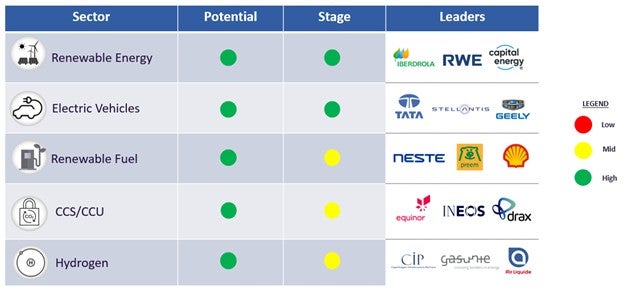For the last decades, Europe has committed to reducing fossil fuels usage to bring down regional emissions while taking advantage of its renewable resources. High volumes of thermal energy imports, as gas and oil, coupled with an increasing interest in bringing down emissions, have paved the way for an increased uptake of renewables across multiple industries.
GlobalData’s most recent report on Energy Transition in Europe has positioned Europe with a high potential to be the leading region in the five main sectors needed for energy transition, two of which are currently at a high development stage, namely renewable energy and electric vehicles. But even being leaders in these two sectors, further policies and actions need to be implemented to increase its capacity in renewable fuels, carbon capture and hydrogen. Derived by the development of those five energy transition sectors, Europe’s emissions fell by 21% between 2005 and 2017, supported by improving climate policies, renewables adoption and the development of sustainable fuels, which will help to keep its climate goals on track.
Energy supply
Even when in 2021, renewables made 49% of the total power capacity while coal, gas and oil held a 42% share, the energy supply sector was still the main responsible for the CO2 emissions in the region. The capacity and generation outlook suggests that, while it is probably that the region has made the most significant progress in achieving its targets to reduce emissions and become net zero, further work is still needed to develop technologies which can support a renewable-based economy, such as robust energy storage capacity. Europe has a high renewable potential due to its high hydraulic reserves and its wind resources, in which the North Sea has become an attractive area for developing wind projects. Following this, the European Parliament has adopted various strategies to encourage renewable energy and achieve a net zero continent by 2050, and also several countries have set strict policies on phasing out coal and reducing fossil fuel use, following firm progress on decommissioning thermal capacity.
Leading sustainable transportation
Electric vehicles are a key step for meeting the target of net-zero emissions, as the transportation sector is the second largest emitter of CO₂. Europe is known as the main region to build policies and funding to support electric vehicle adoption, having banned the sale of fossil-fuel vehicles from 2035. To keep transportation emissions as low as possible and with an aim to displace internal combustion engines, lawmakers have also endorsed a 55% emissions reduction from automobiles and 50% from vans by 2030, compared with 2021 levels. The automotive industry and automakers are also aligned to these EU targets, with a common obligation to reduce CO₂ emissions from the auto industry by 38% by 2030 compared to 2021.
This has led to the deployment of electric vehicles (EVs) and Plug-in hybrid electric vehicles (PHEVs) across Western and Central Europe, which the report shows a total growth of 15 million units in the market by 2036. As part of its strategy to boost EV use, it is keeping financial incentives and increasing charging infrastructure, which are the main drivers that will accelerate the uptake of electric vehicles in Europe.
Diversifying with clean technologies
Technologies supporting emissions reduction across industries is a key target for the region, as not every sector can be electrified or be supported by renewables. There’s a clear need to start developing and investing in clean technologies which can back up heavy industries to keep aligned with the EU net-zero targets.
How well do you really know your competitors?
Access the most comprehensive Company Profiles on the market, powered by GlobalData. Save hours of research. Gain competitive edge.

Thank you!
Your download email will arrive shortly
Not ready to buy yet? Download a free sample
We are confident about the unique quality of our Company Profiles. However, we want you to make the most beneficial decision for your business, so we offer a free sample that you can download by submitting the below form
By GlobalDataIn such a sense, European countries have started developing renewable refineries to increase their renewable fuel production as part of an integrated strategy for reducing emissions in the most energy-intensive industries, such as aviation fuels. Production growth of renewable fuels such as sustainable aviation fuels and renewable diesel is very promising in the region, with regional capacity leaders being the Netherlands, Sweden and Finland. With the development of the projects currently announced, Europe will have a total capacity of over 1,800 million gallons per year by 2027.
Carbon Capture has brought decarbonization improvements in power plants and is being implemented across multiple industry sectors, as it is critical for a lower-carbon future and essential to achieving the net-zero goals. High energy-consuming industries such as cement production, SAF and steel production have started adding CCS into their operations to reduce their emissions as heavy industries. There has been an increasing number of demonstration and pilot projects that have been developed over recent years, but only a few large-scale projects have been announced. There is a need to secure future carbon capture capacity as well as increasing carbon storage capacity.
Apart from a rising share of renewables within the power market, the development of new technologies such as low-carbon hydrogen are driving change in cleaner energy sources. GlobalData’s report shows the EU low-carbon hydrogen market promising significant growth by 2030, accounting for a 20% share of the global capacity.






Related Company Profiles
CCS Inc.
Saf